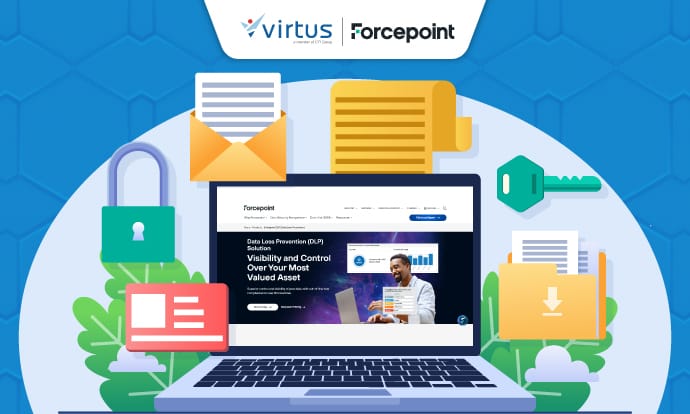Data security has become a primary focus for companies in 2024. According to IBM’s latest report, the global average cost of a data breach in 2024 has reached $4.88 million, a 10% increase compared to the previous year. Even more concerning, 1 in 3 data breaches involves shadow data—hidden or untracked data that is difficult to manage. This highlights the rapid data growth and the significant challenges companies face in safeguarding their sensitive information.
On the bright side, companies that use AI and automation in their security strategies are saving an average of $2.22 million per incident. With the average cost of a data breach in cloud environments hitting $5.17 million, it’s clear that businesses need robust solutions like Data Loss Prevention (DLP) to stay protected.
In this article, we’ll dive deeper into why data security matters, the common threats businesses face, and the smart ways to protect sensitive data.
What is Data Security?
Data security is a combination of policies, procedures, and technologies designed to protect data from unauthorized access, theft, or modification. Key approaches like encryption, access control, and backup ensure data’s integrity, confidentiality, and availability throughout its lifecycle. It’s an essential part of keeping businesses running smoothly and complying with strict regulations.
Types of Data Security
There are various methods to safeguard your company’s digital assets. Here are some key ones you should know.
Encryption
Encryption turns data into unreadable code that can only be unlocked with a decryption key. It ensures data remains secure, whether it’s stored or being transmitted.
Access Control
This restricts access to sensitive data, using methods like multi-factor authentication and role-based access control (RBAC) to ensure only authorized users can access important information.
Backup and Recovery
Regular data backups and a recovery plan allow companies to restore lost data due to cyberattacks or natural disasters, ensuring business continuity.
Data Masking
This hides sensitive data by replacing it with fictitious information, so even if it’s accessed by unauthorized users, it’s useless to them.
Risk-Adaptive Protection
This uses behavioral analytics to automatically adjust security policies in real-time, providing more flexible and responsive protection.
Data Integrity Protection
Hashing algorithms ensure that data isn’t altered during storage or transmission without authorization.
Tokenization
This replaces sensitive data with tokens that are meaningless to attackers, commonly used in financial transactions to protect credit card data.
Data Auditing
Tracking data access and activities to identify suspicious actions, ensuring compliance and overall data security.
Anonymization
This technique removes or masks personal identifiers from data, making it impossible to trace the information back to an individual.
What are the Key Data Security Threats?

As technology advances, so do the threats to data security. Here are some common threats to be aware of.
Malware Attacks
Malware, such as viruses, ransomware, and trojans, is designed to damage or steal data, often leading to significant financial losses.
Phishing
Phishing schemes trick users into giving away sensitive information like login credentials by pretending to be a trusted entity.
Insider Threats
These come from within the company—either accidental or deliberate actions by employees—that can result in data breaches.
Man-in-the-Middle (MITM) Attacks
This occurs when attackers intercept and manipulate communication between two parties, often to steal sensitive information or disrupt transactions.
Distributed Denial of Service (DDoS) Attacks
These attacks flood services or networks with excessive traffic, causing downtime and disrupting services.
Read More: Here’s The Reason Data Security Should Be a Top Business Priority
Data Loss Prevention: The Key Pillar in Protecting Data
Data Loss Prevention (DLP) is a critical technology designed to stop sensitive data from leaking due to human error, unauthorized access, or cyberattacks. DLP keeps track of data flow in and out of your company’s systems, ensuring sensitive information doesn’t escape through emails, cloud platforms, or endpoint devices.
Choosing the right DLP solution is vital to maintaining data security. Forcepoint DLP stands out with advanced features that help businesses protect their sensitive information against the ever-evolving threats of the digital age.
Optimize Your Data Security with Forcepoint DLP

Forcepoint DLP is an advanced solution designed to provide adaptive protection against risks using AI and automation. It covers cloud, email, web, and endpoint devices, offering a holistic approach to keeping company data secure.
One standout feature of Forcepoint DLP is Risk-Adaptive Protection, which automatically adjusts security policies based on user behavior and real-time threats. AI-powered data classification also helps businesses accurately detect and secure sensitive information, such as personally identifiable information (PII) and intellectual property.
Top 8 Features of Forcepoint DLP
Here are 8 key features that make Forcepoint DLP the perfect choice for securing your company’s data.
1. Forcepoint ONE Data Security
Provides full coverage for your cloud, endpoints, and emails, ensuring no gaps in your data security strategy.
2. Forcepoint DSPM
Automates the discovery and classification of sensitive data, making it easier to protect what matters most with minimal effort.
3. Risk-Adaptive Protection
Automatically adjusts security policies in real-time based on user behavior and detected risks, offering flexible and dynamic protection.
4. Forcepoint Data Classification
Uses AI to tag sensitive data, helping you manage and secure your critical information without the usual complexities.
5. Forcepoint ONE Data Security for Email
Locks down your email communications, ensuring sensitive data doesn’t leak through your primary communication channel.
6. Forcepoint DLP for Cloud Email
Integrates on-prem DLP with cloud email, ensuring comprehensive protection for your cloud-stored data.
7. Forcepoint ONE CASB and SWG
Provides strong security control for cloud applications and web gateways, safeguarding your data from external threats.
8. Forcepoint Enterprise Data Loss Prevention
Unified policy across endpoints, network, cloud, web, private apps, and email, with 1700+ pre-built classifiers and templates, supporting structured and unstructured data protection.
Success Story: Forcepoint at VAKIFBANK
VAKIFBANK, one of Turkey’s largest banks, adopted Forcepoint DLP to comply with GDPR (General Data Protection Regulation) and KVKK (Kişisel Verilerin Korunması Kanunu) regulations while protecting the personal data of 15 million customers. Within just one month, they implemented 50 security policies, secured 20 million sensitive files, and prevented over 4,000 data breach incidents in the first three months.
Forcepoint’s OCR and fingerprinting technology accelerated the detection of sensitive data and potential leaks, while its AI-driven data classification feature made automatic labeling much faster and more efficient.
Protect Your Business Data with Forcepoint DLP and Virtus
As an authorized partner of Forcepoint, Virtus Teknologi Indonesia (VTI) offers tailored solutions to safeguard your company’s data from the increasing complexity of cyber threats. As part of Computrade Technology International (CTI) Group, we offer end-to-end support—from expert consultation to reliable after-sales assistance—ensuring your company’s data security needs are met efficiently by our dedicated team
Data Loss Prevention (DLP) is essential not only for securing sensitive data but also for ensuring regulatory compliance, reducing the risk of breaches, and boosting customer trust. With Forcepoint DLP, you get smart, adaptive protection that evolves with the threat landscape.
Contact us now for the best data security solutions to protect your business!
Author: Danurdhara Suluh Prasasta
Content Writer Intern CTI Group



























